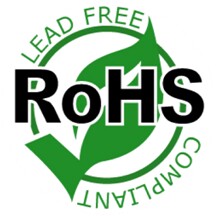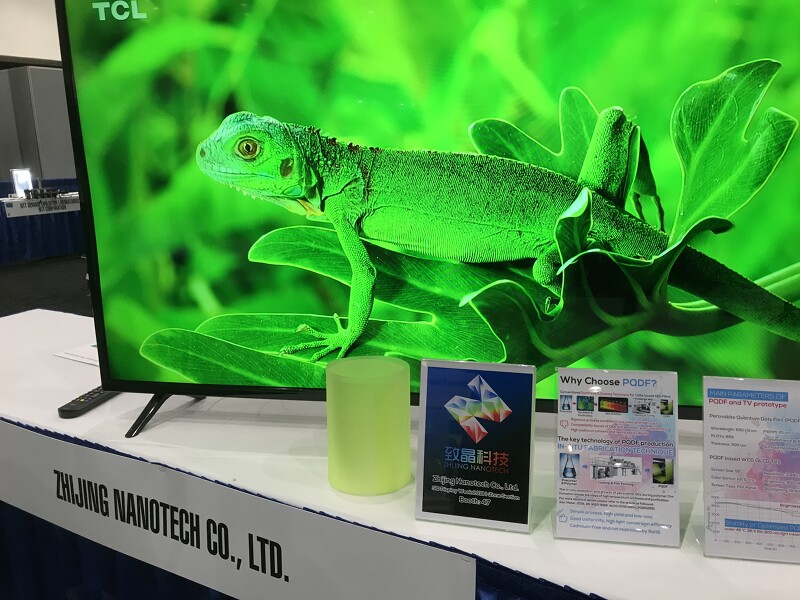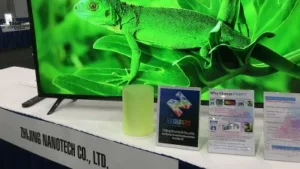By now you have almost certainly heard a thing or two about perovskites either in quantum dot (QD) form or in larger crystallite sizes. Display geeks love them because they have incredibly narrow linewidth, they’re easy to make, and have tunable properties.

In some ways they beat every other emissive technology out there, but they still fall short in many categories. What follows is my take on this up-and-coming technology and how it might (or might not) be the next best thing to happen to LCDs.
You can read my coverage of all QD technologies at SID 2018, including perovskites, in Display Monitor here (Quantum Dot Symposium Roundup – subscription required)
A Brief History
Perovskites took off shortly after 2009 when they were found to be a highly efficient solar cell material. Initial studies resulted in very rapid improvements in efficiency, the likes of which had never been seen in other solar cell materials. In a few short years the efficiency of research devices skyrocketed from <10% to >20%, attracting the interest of researchers around the world. You can read a good review of the solar cell technology here.
Not surprisingly, people started to explore the properties of this semiconductor in quantum dot form. In 2014, a seminal paper demonstrated that they were very attractive for visible light emission, just like other types of QDs. With simple synthesis, tunable emission wavelengths, and ultra-narrow green linewidths, this new QD holds a lot of promise for wide color gamut displays and has seen intense research interest in the past four years.
The Good
They are narrow, very narrow: If QDs have taught us anything, it’s that narrower is better – I know that there is a limit to that statement, but in general it holds true for QD emission linewidths (we’re not talking laser line widths here, QD linewidths are still broader than a blue LED). The incumbent indium-phosphide QDs have linewidths of 35-45 nm depending on who you ask. Cadmium-based technology is regularly around 30 nm. Perovskites cut that in half, with an impressive 15-18 nm linewidth for green (similar to a blue LED linewidth). You don’t need me to tell you what this can do for color gamut, efficiency, and brightness.
A rainbow of perovskite QDs (credit: ACS Publications)
They are easy to make: While QD film prices have dropped considerably in recent years, there is still pressure to decrease this price in order to penetrate the market further. Scaling up QD synthesis can be tricky, and often the desirable properties are lost when going from the lab bench to industrial scale. Perovskites have the advantage of being a very simple and robust synthesis, a far cry from the traditional QD synthesis. Those who brew beer or make QDs know how hard it is to make consistently. This problem should be (partially) alleviated with perovskites due to their relatively simple synthetic process. In fact, some researchers have shown that these materials can be formed in-situ during polymerization of a polymer, even further simplifying the process.
They are tunable: QDs have long been known for their tunability, and perovskites are no exception. One difference is that perovskites are often wavelength-adjusted based on composition, not just size. This can easily be done by adjusting inputs, or performing an ion-exchange after the QDs are made.
The Bad
They contain lead: We all know cadmium-based QDs have had a tough time gaining traction in some parts of the world due to concerns of toxicity (a discussion for another day), and nearly all perovskites contain lead. The film form-factor will likely contain <1000 ppm of lead making it under the RoHS limit. Highly concentrated form factors like color filter replacements, or color converter layers on micro LEDs may exceed the allowed RoHS limit. That “lead-free” stamp of approval that comes on many of the electronic items you purchase is going to be a tough thing to remove for a lot of companies.
 “RoHS compliant” means <1000 ppm of lead (even lead-free solders can contain some lead), so perhaps the “Lead-Free RoHS Compliant” logo would be allowed on TVs with perovskite QD films even though it’s misleading – we’ll have to consult the lawyers on that one.
“RoHS compliant” means <1000 ppm of lead (even lead-free solders can contain some lead), so perhaps the “Lead-Free RoHS Compliant” logo would be allowed on TVs with perovskite QD films even though it’s misleading – we’ll have to consult the lawyers on that one.
They are unstable: The solar cell community has struggled with this too, but it’s especially pertinent in quantum dot form. These types of QDs are not the core/shell type that you typically see with CdSe or InP. This, along with their unique composition, makes them susceptible to degradation from elevated temperature and light flux. Other QD types struggled with this for a long time, but the tricks that work for CdSe or InP don’t work for perovskites.
Color options are limited: I know, I put color tunability as a positive feature too, but in the case of perovskites, the composition-tuned QDs fall into the “extremely unstable” category. In short, the atoms that are substituted to tune color are highly mobile, and when stressed with heat or light they tend to move around, resulting in a color shift. Not desirable for an application that requires stable emission wavelengths. For this reason (among others), green perovskite QD technology is far more mature than its red counterpart.
Future or Fad?
Existing CdSe and InP QDs have taken decades to develop into a robust material suitable for displays, and it’s not likely to change overnight. The 800 pound QLED gorilla (Samsung) is unlikely to adopt a technology with lead or cadmium, so it’s safe to say InP will be around for a while. Other companies, however, might be willing to overlook the lead factor in exchange for a competitive wide color gamut technology. It has been shown that green perovskite QDs paired with red QDs or KSF phosphor can deliver an impressively wide gamut up to ~90% of Rec2020.
So far, the only TV I have seen with a perovskite film had a TCL logo. They showed one at both CES 2018 and SID Display Week 2018. Will we see more in the coming years? I suspect we will at trade shows, but we all know that doesn’t necessarily mean they are ready for prime time.
 A TCL TV with perovskite QD film + KSF demonstrated at SID Display week 2018 (Photo Credit: P. Palomaki)
A TCL TV with perovskite QD film + KSF demonstrated at SID Display week 2018 (Photo Credit: P. Palomaki)
Let’s keep in mind that current QD technology has taken years and years of development by some of the best scientists in the world. Those same scientists have only been working on Perovskite QDs since 2014 and look how far this material has come already! With a focused effort I think the stability problems will be overcome. Some companies are already claiming major improvements in this category. As for the lead problem, lead-free perovskites are an active area of research, but they are still a long way off. Research into new formulations without lead just don’t have the same exciting properties.
Are perovskite QDs the future? Or just a fad? For now, I’ll say the outlook is… favorable. – Peter Palomaki
Peter Palomaki is the owner and chief scientist at Palomaki Consulting, a firm specializing in helping companies solve big problems at the nanoscale. His utilizes his expertise in quantum dots and materials chemistry to solve challenging problems with clients large and small.
www.linkedin.com/in/ppalomaki
@nanopalomaki

